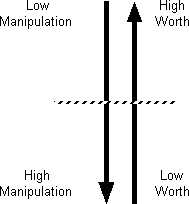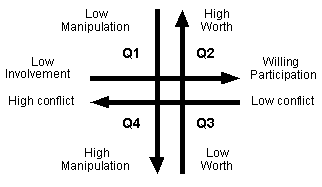|
|
| Home - Industry Article - Feb 07 Issue |
How Much is Your Influence Worth |
By Dr. Marlene Caroselli, Author, “Principled Persuasion”
Leadership guru John Maxwell maintains, “Leadership is influence. That’s it.” He asserts, “Nothing more. Nothing less.” Those leaders who occasionally find themselves seeking balance on the tightrope that spans influence and desired outcomes would do well to consider the ‘worth aspect’ that separates ethical influence from unethical manipulation.
Manipulation is unhealthy, for influencer and influencee alike. As shown in the diagram below, the lines indicating manipulation and worth are parallel, but diametric in value: The more manipulation you feel you have to use, the less worth your concept typically has (or the less creativity you have found to promote the concept).

Manipulative influencers are not typically truthful or open in their transactions; they do not tell the whole story; they move others towards ends that are less than honorable or toward results that have been fraudulently or unfairly earned. The word ‘manipulate’ actually has honest origins – the Latin word, manus, meaning, ‘hand’. Those who used their hands well or who could handle tools well were said to be manipulative. Even today, this meaning is the first given in most dictionaries for the word ‘manipulate’.
And of course, there are some who learn to handle themselves, others, and situations so skillfully that their actions seem contrived. So polished are they in their presentations, so adept at understanding what motivates people, that they appear to go into automatic pilot in dealing with both expected and unexpected occurrences. After a while, their facility with words seems glib, their smoothness too slick, their sincerity suspect. In the extreme, there are those with an uncanny ability to ‘psych out’ other people, to sense what they want to hear and then deliver it. But such individuals form the ranks of fortune-tellers and psychic healers, not the realm in which influencers use integrity as their coin of commerce.
If manipulation seems an easy way out, it very well may be, but not for long. What you lose in reputation and stature will be far more costly than what you gain in expediency. Most people can be exploited once, but will then be distrustful for a long time after.
The overriding goal of influence is working with others to achieve a goal everyone has bought into. When you are the only one supporting the plan despite repeated efforts, and find yourself using any means to reach the end, you may as well abandon the effort – if your intent was to influence with integrity. Influence may not begin with everyone in accord regarding the worth of the end product. However, during the process and by the end of the process, everyone participating has opted for involvement and has agreed to the mission and the work required to reaching that mission.
Using horizontal arrows to represent these extremes, our diagram would look like this:

If we were to use both sets of describers, the complete diagram would have four quadrants, which we'll label Q1, Q2, Q3, and Q4.

Quadrant Characteristics
Think about some person or group whom you have recently influenced, then read the four descriptions that follow, and determine which one best fits these influencing circumstances.
Q1: Low Manipulation / Low Involvement
People who are distinctly non-manipulative may or may not be able influencers. If they are not, they fall into this first quadrant. They inspire little or low involvement on the part of those whom they wish to make part of their mission. Typically, they have intensive commitment to their plan, but lack extensive power over others. To be sure, some plans can be executed by a committee of one (if you are trying to influence your supervisor to give you a raise, for example), but more often you will need the synergy of a team to accomplish extraordinary feats.
- The Problem
Basically, the problem is a lack of confidence – perhaps in yourself, perhaps in the project, perhaps in other people. It’s hard to lead if you are fearful, hard to convince others if you lack enthusiasm or commitment. Confidence may be lagging for other reasons as well: it may be the project is right, but the circumstances are wrong, or the mix of personalities is not right. Also, if circumstances are dictating the mood – if colleagues, for example, are worried about downsizing – the best and best-intentioned influencers will find confidence or enthusiasm almost impossible to muster. If the timing is wrong, little else will be right.
- The Solution
First consider the possible abandonment of this project. It may be better to reserve your energies for one you feel more strongly about. If abandonment is not the answer, you may have to examine your delivery style. If possible, tape record yourself (at least by audio, if not video equipment). Afterwards, with as much detachment as you can garner, critique yourself. Would you be willing to do something with or for the person on this tape on the basis of the delivery you are now hearing or watching?
There is another possibility if you feel your influencing is of the Q1 variety. Do some ‘exit’ interviews. After an overture that did not involve or excite your prospective influencees, call them one by one, or meet with them, and simply ask, “What could I have done differently that might have made you more involved?”
Q2: High Worth / Willing Participation
The very fact that your project can be described as having high worth may be the reason participation in it is so willingly given. Little outright influencing is needed after presenting your plan to your influencees, for your idea is probably speaking for itself. Typically, in high worth / willing participation situations, the individuals involved have worked together before or know each other well or know you well. Consequently, trust and positive feelings run high.
-
The Problem
There is a danger here, however. It’s called groupthink. When the members of a group like each other and the leader, they are less contentious or questioning than they might otherwise be. The unspoken need to conform socially may in fact cause some decisions to be made before their time.
- The Solution
Ask one person (ideally, the most analytical thinker among you) to deliberately play the role of devil’s advocate. He will purposely rain on the collective parade whenever it seems the group is being swept away by their own enthusiasm. This person will ask questions, cite data, get outside opinions – whatever is necessary to ensure final decisions have been subjected to the scrutiny they deserve.
Q3: Low Conflict / Low Worth
Properly channeled, conflict may be the best thing that can happen to your influence efforts. But it must be the kind of conflict that is characterized by debate rather than vitriolic observations. If there is low conflict, there is probably low interest. As a group moves from the opening stage of the project (at which they are assembling and getting to know one another) to the conflict stage, questions, challenges, and territoriality issues can and should emerge. Until agendas are uncovered and conflict resolved, the team will not be able to move to the productive stage (at which agreement is reached on operational concerns) and will not ever achieve the accomplishment stage (at which objectives are met). If there is little external conflict, there may be little worth associated with the project. People simply do not care enough to object to it.
- The Problem
There may be two problems associated with low conflict / low worth. The lack of conflict may not be a lack of interest at all. Rather, something else may be governing the reactions of those you have chosen to influence. For example, if your position is senior to theirs, they may not be speaking up for fear of jeopardizing their standing.
- The Solution
One way to move the group to debate is to use Delphi deliberations, a group dynamics technique originated by the ancient Greeks. Simply ask those you wish to be involved in your project to anonymously record their thoughts about its worth, about their feelings at the moment, about what you have said so far, etc. Then ask them to fold their papers and pass them to you. One at a time, you can read the comments and open each to discussion and to the conflict that is so healthy to progress.
If the majority continues to evince little faith in the project, you will either have to resell it, repackage it, reject it, or resurrect it later.
Q4: High Manipulation / High Conflict
By the time most of us are old enough to enter the workforce, we know when we are being conned and know we do not like it. Only the truly naive can be manipulated without some conflict erupting within them. It may be only a voice whispering inside their heads, “This isn’t right” or “This is too good to be true.” But almost always, there will be an indication that we are in danger of being duped. (Similarly, the manipulator knows when he is operating in a manipulative fashion.)
The conflict may take any one of several forms: self-doubt, discomfort, worry, stress, and fear. Or it may be expressed in the form of verbal conflict with the manipulator. Suspicion leads some to resort to a more covert means of resolving the conflict within them, such as initiating a background check or using hidden cameras.
- The Problem
If your intuition, common sense, past experience, or friend is telling you something is wrong, something probably is. The internal conflict you are experiencing is the best reason to investigate the situation further. Chances are, someone is withholding information you need before making up your mind to commit your time, savings, or heart to this individual.
- The Solution
Stall. Before committing yourself or your funds, ask for more time. Then confer with others to learn more about the potential manipulator and his history. Of course, some issues don’t warrant such investments. In these cases, you can simply but firmly ask, “Is there something you’re not telling me?” You could also tell the manipulator that you are not comfortable doing what he has asked of you and let that be the end of it.
Dr. Marlene Caroselli, author of 58 business books, is an international keynote speaker and corporate trainer for Fortune 100 companies, government agencies, educational institutions, and professional organizations. She contributes frequently to a number of well-known publications (among them are Stephen Covey’s Excellence Publications and the National Business Employment Weekly). Marlene’s first book, “The Language of Leadership” was chosen as a main selection by Newbridge’s Executive Development Book Club. A more recent title, “Principled Persuasion”, was named a Director’s Choice by Doubleday Book Club. Her latest book, “50 Activities for Promoting Ethics in the Organization” has been co-released by HRD Press and the American Management Association. For article feedback, contact Marlene at mccpd@frontiernet.net
 

|
|


|

